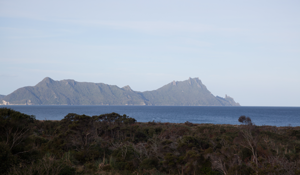
Photo Credit: Russellstreet - CC BY-SA 2.0
On 25 November 1769, the Endeavour sailed into a large bay. Cook commented:
We had no sooner came to an [anchor] than we caught between 90 and a hundred Breams, (a fish so called) this occassioned my giving this place the name of Bream Bay
The fish was probably snapper.
Cook also referred to the headland to the north as Bream Head and the headland to the south Bream Tail. Tail is not a normal term for a headland, but may have been applied because it sat at the other end of the bay from the ‘head’. This may be another of Cook’s little jokes, like the Poor Knights Islands, Cape Brett and Piercy Island.
In 2012, the Ngāti Manuhiri Claims Settlement Act restored the original name Paepae-o-Tū. The Statement of Association provided by Ngāti Manuhiri said Paepae-o-Tū is:
The standing place of Tū, is the traditional name for the coastal promontory more commonly known today as Bream Tail. The name is of major spiritual significance as it is associated with Tūmatauenga – the deity associated with man and war. Paepae-o-Tū is also significant as it marks the northern boundary of the Ngāti Manuhiri Rohe.
References
- NZ Gazetteer - Paepae-o-Tū / Bream Tail
- NZ Gazetteer - Bream Head
- NZ Gazetteer - Bream Bay
- James Cook, ’25 November 1769’, South Seas: Voyaging and Cross-Cultural Encounters in the Pacific (1760-1800)
- JC Beaglehole (ed), The journals of Captain James Cook on his voyages of discovery, Vol. 1, Hakluyt Society, Cambridge (England), 1955, pp. 210-211